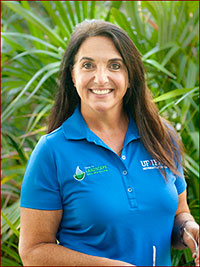Wendy's Wanderings
December 11, 2019
Managing Wisely
In a recent conversation with a farmer, he said to me, "The less I spray, the less I have to." He was speaking about insect control on his fruit trees. It took me a second or two to catch his drift, but once I did we shared the concept of protecting beneficial insects so they can control the pest insects.
This also can apply to your home garden and even your indoor plants. If you have a scale or aphid infestation on an indoor plant, often times the best action to take is to move the plant outdoors (in comparable light exposure) so the pests' natural enemies (either predators or parasitoids) can help to reduce the pest problem.
In the landscape and vegetable garden you can use Integrated Pest Management (IPM) to control pests responsibly. The first step to this plan is our old mantra, "Put the right plant in the right place."
When selecting plants for the landscape understand the growing conditions that are ideal for the plant, and if you don't have those conditions, don't use that plant. Note too, if the plant has a pest named after it, you may want to sincerely consider what your threshold is for pests; think oleander caterpillar, crapemyrtle aphid, squash vine borer, and snowbush spanworm.
If your new favorite plant has favorite pest, you will really have to step up the scouting. Scouting is a critical technique in IPM. Scouting is where you regularly examine the plants in the landscape and garden to determine if you have a pest problem and if the problem is reaching damaging levels. Anyone can scout, just grab your magnifying hand lens, enter the garden, and start flipping leaves and inspecting stems and fruits.
Look for signs of pests as well as the pests themselves. Signs you would see on your scouting trip are caterpillar frass, webbing, honey dew, and sooty mold growing on honey dew. When you see the signs look for the pests, they hide under leaves, in rolled leaves, camouflaged on the stem/trunk and sometimes inside the plants.
When you find the pests, look for the predators and parasites that might be feasting on these insects. I know you know what the ladybug (biocontrol poster child) looks like, but can you recognize their voracious aphid-munching larva? They look like tiny orange and black alligators. The same goes for green and brown lace wings — their larvae are also aphid vacuums. Flower flies, bigeyed bugs, minute pirate bugs, and predatory stink bugs will eat up soft-bodied pests in the landscape and garden.
But how do you know the difference between the good guys and the bad ones? Here are a few hints: the predators are usually bigger than what they are eating and there are fewer of them than the pests. The parasitic wasps that lay their eggs into pest insects are very small and you rarely see them. You will though see the damage they leave behind in the form of aphid mummies or on scale insects that have "exit holes" in them.
The UF/IFAS document "Natural Enemies and Biological Control" has excellent drawings of beneficial insects.
Conserving naturally-occurring beneficial insects is the best way to strike a balance between good bugs and bad bugs in your landscape. Do this by not using pesticides if they aren't needed, and by using the least toxic method of control if they are warranted. Establishing plants that provide alternative food sources like pollen and nectar helps beneficial species because they feed on the pollen. Include cilantro, fennel, and buckwheat to increase the pollinators and to feed your beneficial insects.
-- Wendy Wilber

